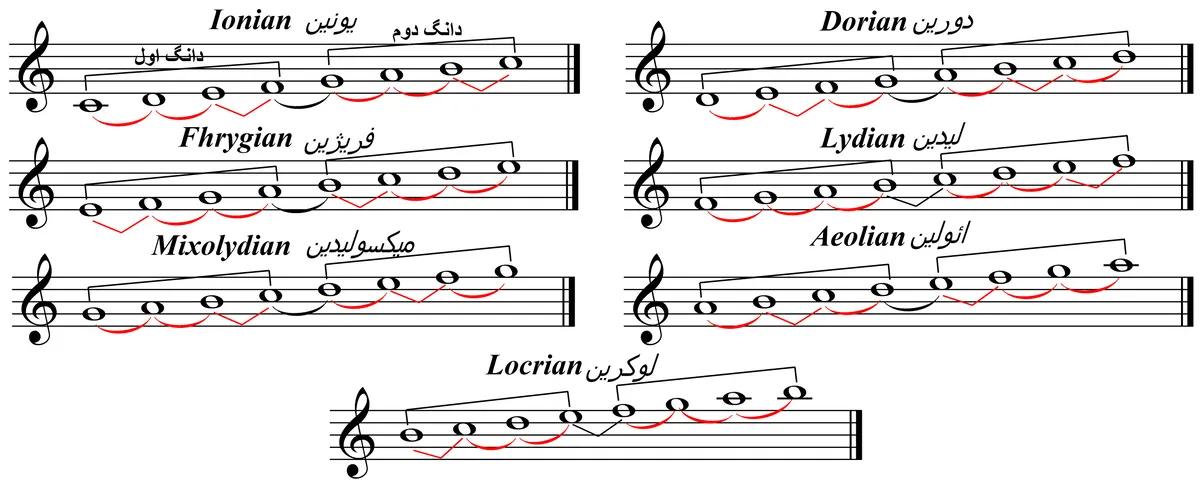Did you know that Samuel Barber's Adagio for Strings and Ralph Vaughan Williams's Tallis Fantasia are both written in the Phrygian mode? Or that large sections of Sibelius's beautiful, limpid Sixth Symphony are in the Dorian mode? If your answer is along the lines of 'no, I don't think I did' (or, indeed, ' sorry, what?'), read on...
First up: what are these modes, anyway?
What are modes?
Well, modes are scales derived from the diatonic (major) scale, each with its own unique sequence of intervals, creating distinct tonal colors and moods. Modes are fundamental in Western music theory and are widely used in genres ranging from classical to jazz, folk, and modern popular music. Each mode has seven notes and includes two intervals that are semitones (half steps) and five intervals that are tones (whole steps).
Originating in ancient Greece, modes existed long before the modern concept of ‘keys’. Instead, each mode began on a different note of the scale – so in a scale of C (or the key of C as we think of it in modern classical theory), the first mode begins on C and ends on the C an octave above, the next mode begins on D and ends on D the octave above, the third mode begins on E and ends on E the octave above, and so on.
Modes are therefore a way to reorder the pitches of a scale so that the focal point of the scale changes. In a single key, every mode contains the exact same pitches, but the emphasis changes to create different moods or characters.
Related to diatonic modes are eight Gregorian modes (or church modes), which became popular in medieval Europe, and which form the basis of Gregorian chant. These, however, are quite different to the diatonic modes discussed below.
What’s the difference between modern scales and modes?
A musical scale is a set of pitches within an octave arranged in ascending or descending steps. In Western classical music scales are identified via set intervals (tones or semitones – or whole or half steps) to form generally understood major and minor variants (such as natural, harmonic and melodic minors). These variants can be applied to different keys, such as C, D, E etc.
The modes are simply versions of a parent scale. So, in C major (C – D – E – F – G – A – B – C), the first mode begins on C, but by keeping the same pitches and beginning the sequence on D (D – E – F – G – A – B – C – D), we create the second mode of the major scale.
How many modes are there?
There are seven modes, each with an ancient Greek name: Ionian, Dorian, Phrygian, Lydian, Mixolydian, Aeolian and Locrian. Some are major modes as understood in Western classical music, some are minor, and some are less clear.
Broadly speaking, however, three of the modes are mainly major: Ionian, Lydian and Mixolydian, and four of the modes are mainly minor: Dorian, Phrygian, Aeolian and Locrian. In the major modes, the third note of the scale is a major third above the tonic (first note) and in the minor modes, the third of the scale is a minor third above the tonic.

The seven musical modes - and a work written in each
Ionian Mode
Ionian mode is the first mode and is the same as a modern major scale – the third of the scale is a major third above the tonic. Lending a cheerful, upbeat feel, the Ionian Mode is found right across pop, rock and classical music.
Ionian mode example: Where do we start? OK, The Beatles' 'Let it Be'. Or Mozart's Concerto for Flute and Harp.
Dorian Mode
Dorian mode is the second mode and is very similar to a modern natural minor scale – the third note of the scale is a minor third above the tonic, but the Dorian sixth note is a major sixth above the tonic rather than a minor sixth, as in the natural minor.
Dorian mode example: In Camille Saint-Saëns's Carnival of the Animals suite, the 'March of the Lions' uses the Dorian mode to evoke a somewhat 'Oriental' feel.
Phrygian Mode
Phrygian mode is the third mode and again is similar to a natural minor scale – except that the second note is a minor second above the tonic, rather than a major second.
Phrygian mode example: Samuel Barber, Adagio for Strings
Lydian Mode
Lydian is the fourth mode and is almost the same as a modern major scale – except that the fourth note above the tonic is augmented (raised).
Lydian mode example: The Police, 'Every Little Thing She Does is Magic'
Mixolydian Mode
Again, this fifth mode is almost the same as a modern major scale – but this time the seventh note above the tonic is flattened to produce a minor seventh rather than a major seventh.
Mixolydian mode example: The third movement of Grieg's Piano Concerto
Aeolian Mode
This sixth mode is the same as a natural minor scale, with flattened sixth and seventh notes above the tonic.
Aeolian mode example: The Christmas carol 'God Rest Ye Merry Gentlemen'.
Locrian Mode
The seventh mode is a minor scale but with an added minor second and diminished fifth above the tonic.
Locrian mode example: Benjamin Britten uses the Locrian mode for the ninth song in A Ceremony of Carols, 'In Freezing Winter Night'.
How are modes used in modern music?
The Ionian mode is another name for the major scale used in much of Western music, while the Aeolian mode is the same as the most common Western minor scale, the natural minor.
Modal melodies are often found in traditional folk music – Irish traditional music, for example, uses the Mixolydian, Dorian and Aeolian modes, while a great deal of Flamenco music is in the Phrygian mode. Modern pop songs, too, can often be modal in construction, accounting for their feeling of being neither entirely major nor minor.
Simon and Garfunkel's Scarborough Fair is written in the Dorian mode
Of the classical composers, Zoltán Kodály, Gustav Holst and Manuel De Falla most notably used modal elements in their music, as did Claude Debussy and Béla Bartók.
